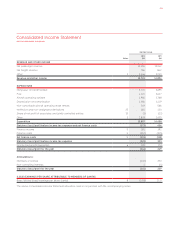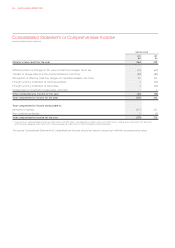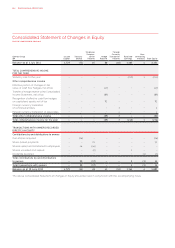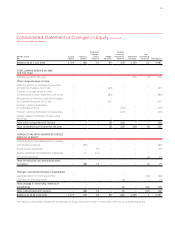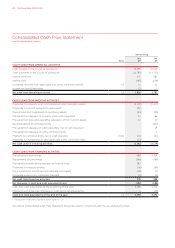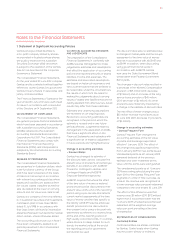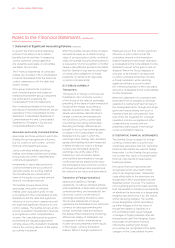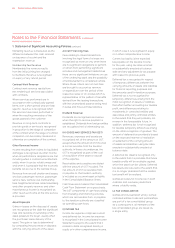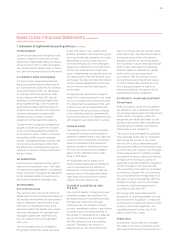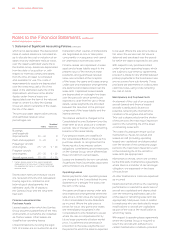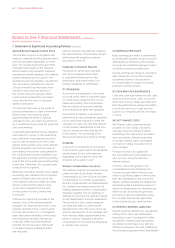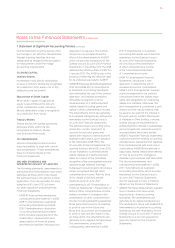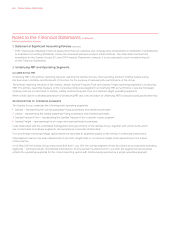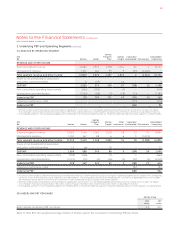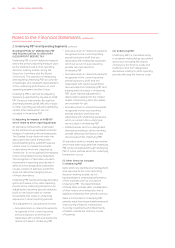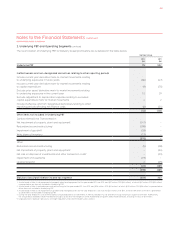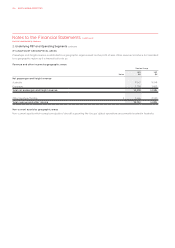Qantas 2012 Annual Report Download - page 76
Download and view the complete annual report
Please find page 76 of the 2012 Qantas annual report below. You can navigate through the pages in the report by either clicking on the pages listed below, or by using the keyword search tool below to find specific information within the annual report.
FOR THE YEAR ENDED 30 JUNE 2012
Notes to the Financial Statements continued
Marketing revenue is measured as the
difference between the cash received
on issuance of a point and the
redemption revenue.
Membership Fee Revenue
Membership fee revenue results
from the initial joining fee charged
to members. Revenue is recognised
on expiry of any refund period.
Contract Work Revenue
Contract work revenue results from
the rendering of services associated
with contracts.
Where services performed are in
accordance with contractually agreed
terms over a short period and are task
specific, revenue is recognised when
the services have been performed or
when the resulting ownership of the
goods passes to the customer.
Revenue on long-term contracts to
provide goods or services is recognised
in proportion to the stage of completion
of the contract when the stage of contract
completion can be reliably measured or
otherwise on completion of the contract.
Other Revenue/Income
Income resulting from claims for liquidated
damages is recognised as other income
when all performance obligations are met,
including when a contractual entitlement
exists, when it can be reliably measured
and when it is probable that the economic
benefits will accrue to the Qantas Group.
Revenue from aircraft charter and leases,
ancillary passenger revenue, passenger
service fees, Qantas Club membership
fees, freight terminal fees, retail/advertising
and other property revenue and other
miscellaneous income is recognised as
other revenue/income at the time service
is provided.
Asset Disposals
Gains or losses on the disposal of assets
are recognised at the date the significant
risks and rewards of ownership of the
asset passes to the buyer, usually when
the purchaser takes delivery of the
asset. The gain or loss is determined
by comparing the proceeds on disposal
with the carrying amount of the asset.
Aircraft Financing Fees
Fees relating to linked transactions
involving the legal form of a lease are
recognised as revenue only when there
are no significant obligations to perform
or refrain from performing, significant
activities and management determines
there are no significant limitations on use
of the underlying asset and the possibility
of reimbursement is considered remote.
Where these criteria are not met, fees
are brought to account as revenue
or expenditure over the period of the
respective lease or on a basis which is
representative of the pattern of benefits
derived from the leasing transactions,
with the unamortised balance being held
in lease and hire purchase liabilities.
Dividend Revenue
Dividends are recognised as revenue
when the right to receive payment is
established. Dividends from foreign entities
are recognised net of withholding tax.
H GOODS AND SERVICES TAX GST
Revenues, expenses and assets are
recognised net of the amount of GST,
except where the amount of GST incurred
is not recoverable from the taxation
authority. In these circumstances, the
GST is recognised as part of the cost
of acquisition of the asset or as part
of the expense.
Receivables and payables are stated
with the amount of GST included. The
net amount of GST recoverable from,
or payable to, the taxation authority
is included as a current asset or liability
in the Consolidated Balance Sheet.
Cash flows are included in the Consolidated
Cash Flow Statement on a gross basis.
The GST components of cash flows arising
from investing and financing activities
which are recoverable from, or payable
to, the taxation authority are classified
as operating cash flows.
I INCOME TAX
Income tax expense comprises current
and deferred tax. Income tax expense
is recognised in the Consolidated Income
Statement except to the extent that it
relates to items recognised directly in
equity or in other comprehensive income,
in which case it is recognised in equity
or in other comprehensive income.
Current tax liability is the expected
tax payable on the taxable income
for the year, using tax rates enacted
or substantially enacted at balance
date and any adjustment to tax payable
with respect to previous years.
Deferred tax is recognised in respect
of temporary differences between the
carrying amounts of assets and liabilities
for financial reporting purposes and
the amounts used for taxation purposes.
Deferred tax is not recognised for
temporary differences arising from the
initial recognition of assets or liabilities
that affect neither accounting nor taxable
profit, and differences relating to
investments in controlled entities and
associates and jointly controlled entities
to the extent that they will probably not
reverse in the foreseeable future. In
addition, deferred tax is not recognised
for taxable temporary differences arising
on the initial recognition of goodwill. The
amount of deferred tax provided is based
on the expected manner of realisation
or settlement of the carrying amount
of assets and liabilities, using tax rates
enacted or substantially enacted at
balance date.
A deferred tax asset is recognised only
to the extent that it is probable that future
taxable profits will be available against
which the asset can be utilised. Deferred
tax assets are reduced to the extent that
it is no longer probable that the related
tax benefit will be realised.
Qantas provides for income tax in both
Australia and overseas jurisdictions
where a liability exists.
J TAX CONSOLIDATION
Qantas and its Australian wholly-owned
controlled entities, trusts and partnerships
are part of a tax consolidated group.
As a consequence, all members of the
tax consolidated group are taxed as
a single entity.
1. Statement of Significant Accounting Policies continued
QANTAS ANNUAL REPORT 2012074



